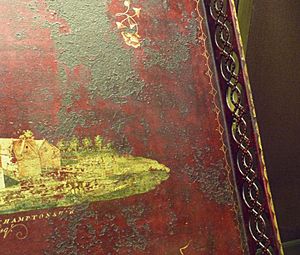Pontypool japan facts for kids
Pontypool japan is a special way of coating metal objects. It's like a very tough paint that uses an oil varnish and heat. This method is often credited to Thomas Allgood from Pontypool, a town in South Wales.
In the late 1600s, Thomas Allgood was looking for a way to stop iron from rusting. He created a recipe that included asphaltum (a tar-like substance), linseed oil (from flax seeds), and burnt umber (a brown pigment). When this mixture was put on metal and heated, it turned black and became incredibly strong and long-lasting.
Pontypool is located in a deep valley, surrounded by areas where coal and iron were mined. The iron used for these items came from furnaces in Blaenavon. Interestingly, much of the "Pontypool ware" was actually made in nearby towns like Usk or Newport.
Contents
The Story of Pontypool Japan
Why Was it Important?
In the late 1600s, making things from thin iron sheets became very popular. This was helped by new machines called rolling mills, which could flatten metal easily. A big challenge was stopping this iron from rusting.
Germany had already developed a way to coat iron with tin, called tin plating. British manufacturers needed their own way to protect metal and compete. This led to the growth of "japanning" on metal.
What Was it Used On?
While tin-plated iron was common, this special coating wasn't just for iron. People also used it on objects made of brass, copper, and bronze. In France, copper was often the main metal used. However, copper had to be hammered into shape, which made its surface uneven. This meant the coating sometimes flaked off more easily than on the smoother English tinware.
Metal objects coated with Pontypool japan could handle heat and water well. This made them perfect for household items like coffee pots, tea sets, and candlesticks. These items could then be decorated in the popular styles of the time.
Many of these old coated metal objects still exist today. This shows how strong and durable the coating was! You can often see the metal underneath if there are scratches or worn areas. If the coating is still perfect, you can use a magnet to check if the object is made of iron. Even tin-plated iron items might show some rust in places.
It's important to remember that back then, there weren't good paints for metal like we have today. Other finishes either didn't stick well or needed special surfaces to bond to. Modern paints made with resins for metals simply hadn't been invented yet.
How Was it Made?
The Secret Recipe
Similar "secret varnishes" were also used in other places, like Birmingham. In his book about Pontypool japan, W. D. John (published in 1953) shared one of these recipes that had been passed down through generations of workers:
- 448 pounds of raw linseed oil
- 22 pounds of lump umber (a natural earth pigment)
- 20 pounds of flake litharge (a lead compound)
- 100 pounds of asphaltum (a sticky, black substance)
- 5 pounds of cobalt resinate (a compound used for drying)
- 406 pounds of white spirit or turpentine (liquids used to thin paints)
Mixing the Varnish
To make the varnish, the linseed oil was heated with the umber and asphaltum. The litharge and cobalt were added slowly. The recipe said the varnish was ready when a drop placed on cold glass stayed in a ball. After it cooled down, the turpentine was added.
There was also a lighter, clear version of this varnish. For that, they simply left out the asphaltum and cobalt. Modern tests have shown that this varnish worked well on both papier mâché and metal plates. Applying three coats of this mixture created a very strong, shiny black finish.
This recipe is quite similar to one for "gold size" that was published by Robert Dossie in 1764 and by Stalker and Parker in 1688. In those versions, linseed oil was boiled with gum animi, asphaltum, litharge, and umber, in similar amounts to the Pontypool recipe. It seems that the basic idea for this "secret recipe" had been around for some time before it was used specifically for coating metal in Pontypool.
See also
- Japan black


